 |
|

|
 |
TABLE of CONTENTS
 |
State wraps up 2015 road construction season |
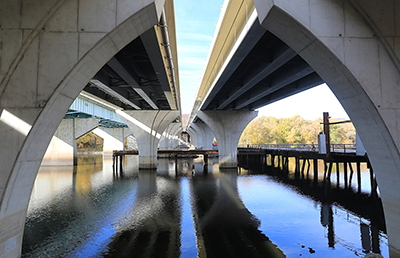
Two separate bridges will replace the current Interstate 90/Dresbach Bridge over the Mississippi River between Dresbach, Minn., and La Crosse, Wis. One bridge is opening this month and the other will be completed in 2016. Photo courtesy of AVS Group |
Many of the state’s 290 construction projects are coming to a close for the season, although a few will continue in some capacity throughout the winter.
“It was a busy, but successful, year for construction around the state. While no one likes the inconvenience that sometimes comes with repairing our roads and bridges, motorists now have safer, smoother roads to drive on,” said Commissioner Charlie Zelle.
“However, while we made progress this summer, Minnesota’s aging, under-funded transportation system is in serious need of additional, significant investments. We look to the Legislature in 2016 to enact a long-term funding solution for transportation to keep our system safe and economically competitive,” he said.
New bridge construction, lane expansion and roadway resurfacing were some of the benefits coming from the 2015 road construction season. Other projects helped improve safety at railroad crossings, and made improvements on runways and terminals at regional airports.
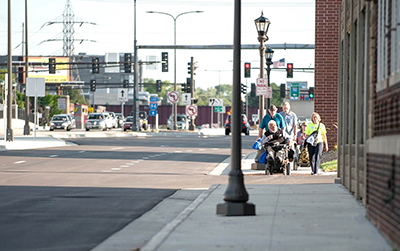
In addition to replacing the Snelling Avenue bridge deck,crews repaved the road, updated pedestrian crossings and installed new sidewalks. Photo by David Gonzalez |
Several projects this year were funded through the $330 million Corridors of Commerce program, a special funding effort aimed at improving roadways with significant freight and commercial use. Without Corridors of Commerce funding, these projects would otherwise be delayed for years.
Statewide project highlights in 2015 include:
Twin Cities
- Hwy 52/Lafayette Bridge – Construction on the two bridges crossing the Mississippi River on the east end of downtown St. Paul will be completed in November. Rebuilding the bridges one at a time saved motorists time and money by allowing traffic to use the existing bridge during construction of the new northbound bridge and then use the new bridge while the new southbound bridge was completed rather than detouring traffic.
- Hwy 51/Snelling Avenue – Crews completed replacing the Snelling Avenue bridge deck, repaved the road surface between Selby Avenue and Pierce Butler Route, updated pedestrian crossings along the corridor and improved drainage. New sidewalks were installed along the corridor. Metro Transit constructed Bus Rapid Transit at four locations for the Metro Transit A Line. The city of St. Paul also added standard decorative twin lantern street lighting.
- Hwy 5 — Crews finished work on a major reconstruction project in early October. Work included adding turn lanes, widening shoulders and improving drainage in Waconia. The reconstruction of the road provides a smoother, safer road with more turn lanes and wider shoulders.
- Interstate 494 rehabilitation between I-394 and the I-94/I-494/I-694 interchange – Crews are repairing and reconstructing the concrete pavement on southbound I-494 between the I-94/I-494/I-694 interchange and I-394, and installing a third lane on southbound I-494 between Hwy 55 and East Fish Lake Road. Several southbound I-494 ramps also have been repaired as part of this year’s work, which is scheduled to be completed in November. The project will be completed in fall 2016.
- I-35E – I-35E in St. Paul was reconstructed between Maryland Avenue and Little Canada Road, including replacing all bridges in the corridor and adding a MnPASS lane in each direction. Much of the major freeway construction between Maryland Avenue and I-94 in St. Paul will wrap up by the end of this year, and the new MnPASS lanes between Cayuga Street and Little Canada Road will open to traffic. Construction is expected to be complete by summer 2016.
- Hwy 100 - Construction on the Hwy 100 project is slated to continue through November 2016. The work involves widening Hwy 100 to include three through lanes of traffic in each direction in St. Louis Park, while replacing bridges and improving ramp safety.
- Hwy 610 – Work will continue throughout the winter on the extension of Hwy 610 in Maple Grove from its current location at Hennepin County Road 81 and Elm Creek Boulevard to I-94 in Maple Grove. The two-year project is expected to be completed by November 2016.
Northern Minnesota
- Hwy 2 Bong Bridge – This two-year preservation project included construction of a roundabout at the Belknap Street/Hwy 2 intersection and the most significant maintenance work done on the Bong Bridge since it opened in 1984. Construction will be complete in November.
- Hwy 70 – Crews resurfaced nine miles of pavement from just east of I-35 to the Wisconsin border. Other work included improving road strength, drainage and sight distances and constructing several new turn-lanes.
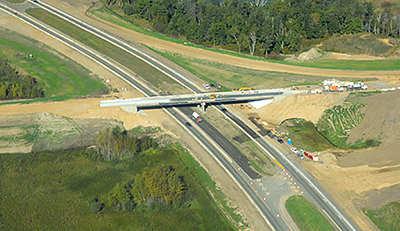
Crews installed an overpass at the intersection of Hwy 2 and Hwy 89 in Bemidji. Photo courtesy of the Bemidji Pioneer |
- Hwy 2/Hwy 89 – Crews replaced the at-grade intersection of Hwy 2 and Hwy 89 in Bemidji with an overpass. This reconstruction project resulted in a safer intersection with improved turning lanes, intersection lighting, and an overpass for motorists on Hwy 89 to access the eastbound lanes of Hwy 2.
- Hwy 2 – The two-year project to stabilize the landslide area in Crookston was completed in August. Crews dug in shear walls, excavated dirt and upgraded storm sewers, which removed weight from the hill and strengthened the slope.
- Hwy 2 – This Corridors of Commerce project involved constructing improvements at 16 locations on Hwy 2 between Cass Lake and Deer River to provide four-lane passing sections, a bypass lane and turning lanes. The project also included tree thinning within the safety clear zone of the Chippewa National Forest to reduce snow and ice compaction on the road surface in the winter.
Central Minnesota
- Hwy 25 – This project completed reconstruction of two miles of Hwy 25 in Monticello, improved utilities, added a new signal system and improved pedestrian accessibility in the area.
- I-94 – Crews completed reconstruction of two miles of I-94 between Rogers and St. Michael. The two-year project added lanes, improved the I-94 bridges spanning the Crow River and constructed a noise barrier near high-density housing along westbound I-94.
- Hwy 24 – Crews began construction on a new Hwy 24 bridge spanning the Mississippi River in Clearwater. The existing two-lane bridge will remain open until the new two-lane bridge opens in fall 2017.
Western Minnesota
- Hwy 10/Hwy 59 – Work on Hwy 10, Hwy 59 and Holmes Street in Detroit Lakes wrapped up in late October. The project included resurfacing Hwy 10, constructing a bridge on Hwy 59 and reconstructing the frontage roads near the two highways. The project will improve safety and traffic flow on the west side of Detroit Lakes.
- Hwy 29 – Crews are nearing completion on a four-lane expansion, county road realignment and roundabout project just south of I-94 in Alexandria. The project will continue next year with the replacement of the current Hwy 29 bridges over I-94, signal and lighting upgrades and interstate ramp improvements.
- Hwy 34 – Passing lanes and intersection improvements were constructed along a 52-mile section of Hwy 34 from Detroit Lakes to Akeley as part of this Corridors of Commerce project. Work began in 2014 and wrapped this fall.
Southeastern Minnesota
- Dresbach Bridge (I-90) – One new river crossing is expected to be open to traffic mid-November with the other crossing expected to be completed in fall 2016. The crossings will replace the existing bridge. Construction work on the interchanges with Hwy 61 and the Minnesota Travel Information Center continues. Workers will be on site during the winter.
- Winona Bridge (Hwy 43) – Pier work advanced significantly for the new bridge across the Mississippi River in Winona. Work also progressed for the approach to the bridge on the Winona side of the river. Construction will continue in the winter so the new bridge can be opened to traffic in fall 2016. Work to rehabilitate the existing bridge will then begin and is expected to be completed by 2019.
- I-35 – This two-year project to replace four bridges and the concrete roadway in both directions of I-35 in Owatonna was completed in early November.
- Hwy 14 – Approximately 2.5 miles of Hwy 14 east of Owatonna was expanded from two lanes to four lanes and opened to traffic in early October. Construction for this Corridors of Commerce project started in July 2014.
- Hwy 14/Hwy 42 – A new roundabout was constructed at Hwy 14 and Hwy 42 near Eyota. The intersection was the scene of dangerous crashes, and the new intersection should reduce the number and severity of crashes.
Southwestern Minnesota
- Hwy 60 – Crews built two additional lanes for Hwy 60 from Mountain Lake to Butterfield to remove a gap in the four-lane system. This project, nearing completion, will improve mobility and safety on an important commercial corridor from southwest Minnesota to the Twin Cities.
- Hwy 5, Hwy 19 and Hwy 22 – A two-year project reconstructing highways in Gaylord was completed this year. The project completes the community’s streets with new utilities, sidewalks, lighting, benches, bike racks and planters.
- Hwy 14 – A Corridors of Commerce-funded project began in July to expand Hwy 14 from Nicollet to North Mankato to four lanes and south bypass of Nicollet with an interchange for Hwy 14/ Hwy 111. Completion is expected by October 2016.
- Hwy 14 – Crews resurfaced 22 miles of Hwy 14. The project also included bridge repair in Florence and Balaton, added accessible pedestrian ramps in Tracy and finished flood mitigation by raising the grade on a half-mile portion of the roadway.
- I-90 preservation projects – Part of a multi-year effort to preserve the aging interstate, almost 69 miles of I-90 were resurfaced in 2015.
- Hwy 12 – This project resurfaced Hwy 12 from Atwater to Litchfield and built accessible pedestrian ramps in Grove City. The project was completed in September.
- Hwy 12 – This project to resurface 7.8 miles of Highway 12 from Kerkhoven to Pennock was completed in July.
- Hwy 59/Hwy 19 – Three inches of road surface were removed on Hwy 59 and Hwy 19 near Marshall and replaced with new asphalt pavement. The bridge over diversion channel was rehabilitated and traffic signals and sidewalks were upgraded to meet ADA standards.
- Hwy 59 – Project to resurface Hwy 59 from Fulda to Slayton was completed in October. ADA improvements were made in Avoca.
- Hwy 30 and Hwy 75 – Hwy 30 and Hwy 75 from Pipestone to Lake Wilson were resurfaced and work was completed in September.
- Hwy 23 – The project included construction of a pedestrian bridge and a reduced conflict intersection in Marshall. The project was completed in October.
For a complete list of 2015 projects, see www.mndot.gov/roadwork/current.html. |
 |
|

|
 |
TABLE of CONTENTS
 |
MnDOT reports an increase in transportation funding gap |
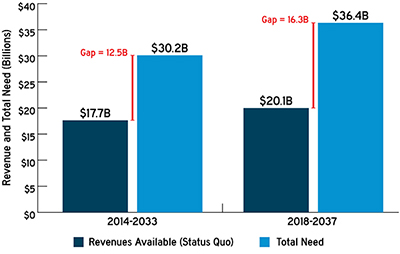
Minnesota will see a shortfall of $16.3 billion in transportation funding over the 20 year period of 2018-2037, according to MnDOT planning experts. That's a gap increase of $3.8 billion from the last 20-year plan. |
The funding necessary to provide Minnesotans with an economically competitive transportation system over the next 20 years has increased significantly, according to recent MnDOT projections.
Planning experts working on the Minnesota State Highway Investment Plan have determined that, during the 20-year period of 2018 to 2037, Minnesota will see a shortfall of $16.3 billion of funding necessary to provide a transportation system that addresses congestion and meets the needs of Minnesota businesses.
That is an increase of $3.8 billion from the previous MnSHIP Plan, which covered the years 2014 to 2033. The unfunded gap in that plan was $12.5 billion.
“Our planning process is thorough and objective,” said Commissioner Charlie Zelle. “It is clearly indicating that the growth in revenue will not meet what we need to spend to provide a competitive system by 2037.”
Zelle attributes gap growth to a number of issues, including:
- Legislative inaction. Since the last MnSHIP, there have been four years of legislative inaction on sustained transportation funding.
- Aging system. Minnesota’s transportation system, the fifth largest in the nation, is coming of age. Half of the state’s highways are more than 50 years old and more than a third of all state bridges are also 50 years or older.
- Exponential deterioration. The longer the state waits to make necessary investments in critical transportation infrastructure improvements, the faster its aging roads and bridges deteriorate. Deferring basic maintenance causes more costly damage to current infrastructure, making improvements more complex and costly to complete.
- Inflation. The cost of materials and labor to fix the system has increased and will continue to do so. A key revenue source for transportation, the state fuel tax, is not indexed to inflation and does not keep pace with rising costs.
- New need requirement categories. MnDOT is now considering flood mitigation and main street projects which provides a more accurate picture of the system’s true needs.
- Better data. MnDOT planners are refining the cost projections associated with roadway infrastructure to have a better understanding of its condition and need. This includes drainage systems, traffic signals, lighting, guardrail, overhead signs, as well as facilities such as rest areas and weigh stations.
The MnSHIP is a federally required document. It is resource constrained, meaning that MnDOT estimates the amount of revenue that will come in, and plans how to use the revenue based on state and agency priorities.
“Minnesota’s infrastructure will continue to deteriorate without a significant infusion of resources to address critical needs,” Zelle said. “There is strong, bipartisan agreement that something must be done to improve transportation funding. It’s up to the Legislature to determine that solution, and soon.” |
 |
|

|
|

|
 |
TABLE of CONTENTS
 |
TIGER grants will bypass freight trains around Willmar, help address truck parking issue |
By Bob Filipczak
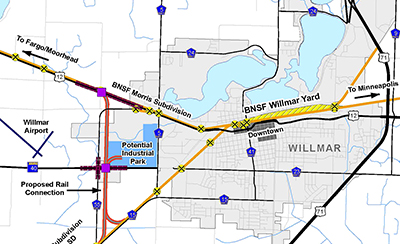
A $10 million TIGER Grant will help build a railroad bypass around Willmar. |
The U.S. Department of Transportation awarded the state of Minnesota a Transportation Investment Generating Economic Recovery or TIGER Discretionary Grant in October for two projects.
A $10 million rail project will help build a railroad bypass around Willmar. When complete, this project will alleviate between seven and 10 freight trains traveling through downtown Willmar every day with all the associated noise and traffic impacts.
“From a railroad perspective, it’s actually doing a lot to help rail transportation and keep those oil cars and other trains from sitting in Willmar and blocking traffic,” said Brian Gage, Program Development and Performance Measurement manager.
This project affects local roads, the Willmar airport and the local economy. First, two new bridges, one on Hwy 12 and another on Hwy 40, need to be built over the new tracks. Since Hwy 40 is the main road to the Willmar airport, it will be important to keep that access open. Finally, the new rail segment gives better freight access to a local industrial park.
“If you focus on the economic impact, the safety impact, the improvement to the freight corridor—those are where you see the benefits,” said Gage.
The second TIGER grant is for $25 million, shared with seven other states, to establish a Regional Truck Parking Information and Management System. The grant proposal stated that this system will be designed to create a new and collaborative way for the Midwest region to address truck parking information and availability need along its busiest freight corridors. The grant will be shared with Indiana, Iowa, Kansas, Kentucky, Michigan, Ohio and Wisconsin.
“With freight traffic increasing, truck drivers often struggle to find safe and legal places to pull over and rest. By helping them find suitable parking spaces, we can combat the problem of driver fatigue on our highways,” said John Tompkins, Office of Freight and Commercial Vehicle Operations.
Tompkins recently led a successful truck parking availability demonstration project along Interstate 94. Research Services created a video on the project, which monitored parking spaces using video technology and relayed the number of available spots at rest stops via changeable highway message boards, signs, in-cab messages and on the web. |
 |
|

|
 |
TABLE of CONTENTS
 |
Road condition cameras enhance 511 system |
|
By Sue Roe

A new feature of the 511 system displays real-time photos of road conditions in 92 locations around the state. |
Motorists driving throughout the state this winter have another tool to help them make good travel decisions. Cameras displaying real-time photos of road conditions in 92 locations are part of the Road Weather Information Stations, or RWIS, on the 511 traveler information website at www.511mn.org.
These camera locations are in addition to the more than 800 traffic cameras already displayed on MnDOT’s 511 system.
The stations are located along state roads and interstates. The stations are used by MnDOT’s maintenance crews but now the public also can take advantage of the live rotating photos of the roadways. Various weather data is also available with the photos.
“RWIS is perfect for Greater Minnesota, where camera images were lacking in the past,” said Kelly Braunig, 511 program manager. “Seeing is believing, so the photos will help motorists know what the road conditions are for where they are traveling."
The RWIS are among several recent enhancements to the 511 system. Other updates are:
- Metro traffic map - Uses Google Speed technology to show congestion levels caused by crashes, closures, construction and maintenance projects within the Twin Cities metro area. Users can zoom in to specific incidents or events. This feature can be viewed by clicking on the quick link “Metro Traffic Map” on the left side of the full-featured version of the 511 website.
- Greater Minnesota traffic speeds – Uses Google Speed technology to show congestion levels along Minnesota highways. Users can zoom in and out to specific cities. Users can view this by turning on the “Traffic Speeds” layer from the dropdown list on the full-featured version of the 511 website.
- Weather warnings – Show warnings imported from National Weather Service sites. The warnings are displayed as a shaded overlay on top of the full-featured version of the 511 website in the areas that are affected. These warnings reinforce the message about the road condition report. For example, if a blizzard warning is issued for St. Louis County, a user would see that county shaded along with a weather warning icon. The user might also see “completely covered” or “travel not advised” road conditions in that area. This feature is available year-round and also shows severe storm, flash flood, high wind and tornado warnings.
- Traffic delays – Is a Google Speed feature that recognizes when there is a backup due to an existing traffic event on 511. The events are highlighted with an orange glow. Clicking on the glowing icon will show details about how long a delay is expected. This is available only on interstates statewide.
- 511 smartphone app – Shows a detour route as a blue line. Detours can also be seen on the 511 website. This feature is available statewide.
“These improvements will give users more quality information,” said Braunig. “The more information we can give the public, the better chance they have to make good decisions on their travel.”
|
Be a 511 citizen reporter
Employees from all areas of the state can sign up to be part of the new citizen reporting feature on 511. Citizen reporting is not a big time commitment and will help the 511 system show updated information on how conditions have or have not changed. To take a short training and sign up, go to www.dot.state.mn.us/onlinelearning/rtmc/citizenreporter. |
|
 |
|

|
 |
TABLE of CONTENTS
 |
Winter Hazard Awareness Week features safety tips |

Snowplow safety is one of the topics to be featured during Winter Hazard Awareness Week Nov. 9-13. Photo by David Gonzalez |
MnDOT is partnering with the Department of Public Safety Division of Homeland Security and Emergency Management to sponsor “Winter Hazard Awareness Week” public information campaign this week.
The week features a media campaign to highlight specific daily topics related to winter weather safety. These resources can be used to help citizens minimize the risks of winter.
Winter Hazard Awareness Week topics are:
Winter Weather Overview – Ice storms, blizzards, sub-zero temperatures, winter weather watches and warnings and wind chill.
Outdoor Winter Safety – Safety on ice, snowmobile safety, hypothermia and frostbite.
Winter Fire Safety – Winter and holiday fire safety, alternative heat sources, smoke detectors, cooking safety, candle and decorations.
Indoor Winter Safety – Carbon monoxide, radon, mold and general home care.
Winter Driving – Auto safety, snowplow safety, road conditions, 511, winter driving tips, car survival kits.
|
 |
|

|
 |
TABLE of CONTENTS
 |
Donated vacation hours sought for five MnDOT employees |
By Rich Kemp
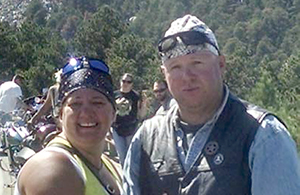
Susanne Herberg and her husband Mark were in a motorcycle crash Sept. 12 and she has exhausted her sick leave and vacation while caring for Mark since the accident. Photo courtesy of District 2 |
Susanne Herberg, account clerk senior in District 2 payroll; Kent Uecker, transportation generalist in the Metro District; Paul Sargent, Support Services Section at Central Office; Wayne (Toby) Tennison, Metro District training; and Thomas Brown, District 2 transportation generalist; are eligible for the state vacation donation program. The program allows employees to donate up to 40 hours of vacation per fiscal year for approved recipients who have exhausted their sick and vacation leave due to injury or illness.
Herberg and her spouse Mark were involved in a motorcycle crash on Sept. 12. Mark sustained life-threatening injuries and had five surgeries to repair internal organ injuries, which were complicated by a prior diagnosis of Crohn’s Disease. Susy has had to exhaust her sick leave and vacation to care for Mark.

Due to a life-threatening blood infection and numerous other serious health conditions, Kent Uecker is eligible for the vacation program. Photo courtesy of Metro District |
Uecker has 26 years of state service and recently came home after a three month stay in the hospital and a transitional care unit due to a life-threatening blood infection and numerous other serious health conditions. Because of his long stay in two different hospitals and a transitional care unit, Uecker’s leg muscles have atrophied and he needs intense physical and occupational therapy to regain the muscle mass in his legs to allow him to walk again and return to work.
Sargent, who has worked at MnDOT for 38 years, was diagnosed with a serious, life-threatening medical condition. He is unable to work due to this condition and will be on leave for an unknown period of time.
Tennison began with MnDOT in 1990. He worked in maintenance and the Bridge Office before joining the training team.
On April 16, Tennison was diagnosed with a life-threatening disease. As a result of his medical condition he is unable to work.
Brown is a transportation generalist at the Deer River Truck Station and has more than 26 years of service.
He has been diagnosed with a life-threatening illness and has encountered complications that have caused him to use all of his sick leave.
Employees may donate up to 40 hours of vacation per fiscal year; however, donations in any amount will be helpful. Hours donated are not considered taxable income for the donor nor are they considered tax-deductible expenses.
To donate, please:
- Log into the State Employee Self-Service website
- Click on “Other Payroll.”
- Click on “Leave donations.”
- Click on “Input Your Leave Donations,”
- Click on the magnifying glass next to “Reserve Bank” to open a list of names.
- Choose the employee’s name you would like to donate to.
- Enter the number of hours that you wish to donate.
- Click on the yellow “Save” box.
A paper form is also available online to donate to an employee on the Vacation Donation Program. |
 |
|

|
 |
TABLE of CONTENTS
 |
Toward Zero Deaths state conference draws record crowd |
By Sue Roe

Inyan Walking Elk, Office of Construction and Innovative Contracting, presents at the Toward Zero Deaths conference in October. Walking Elk gave information on educating the public to help change driver behaviors. Walking Elk helped develop a new video for new drivers. Photo by David Gonzalez |
Distracted driving and child passenger safety took center stage at the 12th annual statewide Toward Zero Deaths conference. A record 964 traffic safety advocates attended the conference Oct. 29-30 in St. Cloud.
Traffic safety officials and stakeholders representing the four E’s of TZD – education, engineering, enforcement and emergency medical and trauma services – attended to share best practices and learn about new approaches to reducing the number of traffic fatalities and life-changing injuries on Minnesota roads.
Matt Richtel, New York Times reporter and best-selling author of a book about distracted driving and the brain, opened the conference, explaining the relationship between the brain and why people are drawn to smartphones and other technology.
“Cell phones tap into our primitive neuro-chemical and social mechanisms. Paying attention to two streams of information is not how we were built,” he said. “If we’re going to get at this problem of distracted driving, we have to understand why we’re doing it in the first place.”
Sue Groth, TZD co-chair and director of the Office of Traffic, Safety and Technology, said Richtel made a compelling case why people should turn off their cell phones and put them out of reach when driving.
“The human brain cannot multi-task, even though we all think we can,” said Groth.
Bethany Olson, a mother who was involved in a severe crash with her two children, opened the second day of the conference. Two weeks before the crash, Olson attended a car seat clinic, where she made life-saving adjustments to her children’s car seats. Olson stressed the importance of providing child passenger safety car seat clinics.
A panel discussion of law enforcement and medical personnel who were involved at the scene and hospital offered their perspectives of the crash.
Several MnDOT employees presented information at the breakout sessions.
The TZD Star Awards were presented to traffic safety partners during the conference. The 2015 award recipients are:
- Kathy Swanson Outstanding Service Award – Nancy Johnson, volunteer and former president of Minnesotans for Safe Driving
- Engineering Award – Tom Dumont, traffic engineer for District 3
- Child Passenger Safety – KaRee Lockling, Injury Prevention Program coordinator at Fond du Lac Reservation Human Services Division.
- Enforcement – Trooper Gabe Cornish, Minnesota State Patrol
- Judicial/Court System – Jack Muhar, Itasca County Attorney
- Media Star Award – KKLN radio, Willmar, Minn.
- Education – Brenda Pohlman, health educator at Fillmore County Public Health and Fillmore County TZD project coordinator
- Emergency Medical and Trauma Services – Deb Syverson, trauma program manager at Sanford Medical Center, Fargo, N.D.
- Distinguished Public Leadership – Gordy Pehrson, Minnesota Department of Public Safety, and Capt. Michael Hanson, Minnesota State Patrol
- Traffic Safety Innovation – Diamond Surface, Inc.
- The DECA team at Eastview High School, Apple Valley, received a special recognition award for its public relations campaign to promote participation at the Point of Impact Teen Driver Safety Parent Awareness classes.
For more information about the award recipients or breakout sessions, visit the TZD website.
The 2016 TZD conference will be Nov. 16-17 in Duluth, Minn.
|
 |
|

|
 |
TABLE of CONTENTS
 |
Richard Davis selected as new Transportation Ombudsman |
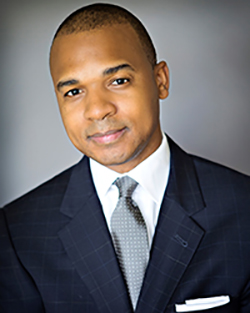
Richard Davis is the new Transportation Ombudsman for MnDOT. Photo courtesy of Davis |
Richard Davis became the new Transportation Ombudsman for MnDOT Oct. 26. He assumed the role formerly held by Deb Ledvina.
Davis has several years of professional experience in both the public and private sector. Prior to relocating to Minnesota, he worked as a consultant for Deloitte in Chicago. For the past several years he has held leadership positions in marketing/communication at Target, Thomson Reuters and Supervalu.
Davis has an MBA from the University of Minnesota’s Carlson School of Management, along with a law degree. Most recently, he worked in public education with Minneapolis Public Schools and as the Chief Communications Officer for Richmond (VA) Public Schools, where he served as the organization’s primary spokesperson and developed multi-channel engagement, outreach and information-sharing strategies.
“We are fortunate to add Richard to the Commissioner’s Staff,” said Eric Davis, chief of staff. “His talent, experience and leadership will not only serve all of us well in the Ombudsman role, but his skills and background will also help strengthen our agency’s on-going and expanding information and outreach efforts.”
Davis will lead the MnDOT Ombudsman Office, providing alternative dispute resolution through neutral, informal and independent conflict resolution. The Ombudsman Office is a resource for both the public and for agency leaders to resolve transportation-related issues that have gone unresolved through traditional processes.
The office participated in Conflict Resolution Week in October by promoting the positive role that alternative conflict resolution processes play within the agency.
In addition, as part of their office WIG, the Ombudsman Office has been joining meetings with groups throughout MnDOT in order to reach more staff, educate districts and expert offices on lessons that have been learned from recent cases, and promote conflict resolution at a deeper level within the agency.
This year, Conflict Resolution Week in Minnesota overlapped with International Conflict Resolution Day on Oct. 15. The focus of the day was to promote awareness of mediation, arbitration, conciliation and other creative peaceful means of resolving conflict in all areas of life.
Now in its seventh year, the Ombudsman’s Office encourages the employees of MnDOT to continue their efforts in resolving conflict with the citizens of Minnesota and to reach out if they need any conflict resolution advice or assistance. |
 |
|

|
 |
TABLE of CONTENTS
 |
New project team to support asset management processes, initiatives |
By Dave Solsrud, Asset Management Project Team

The new asset management project team is made up of (from left) Dave Solsrud, Tom Zimmerman, Trisha Stefanski and Wade Adams. Photo by Rich Kemp |
One of the many outcomes of MnDOT’s Wildly Important Goal effort of Enhancing Financial Effectiveness is the creation of a new asset management project team.
The team is a spin-off of one of the EFE four strategic focus areas, Asset Management.
“In creating this team, MnDOT has made a long-term commitment to implementing lessons learned and processes developed under the EFE efforts of the past two years,” said Jean Wallace, Modal Planning and Program Management Division assistant director.
“The team will continue to expand processes developed during the WIG effort and advance key asset management initiatives into the future. Understanding, forecasting and budgeting for our products and services according to the condition of our infrastructure is critical to the operation of the department, and the efficient management of highway assets,” she said.
Team members are Wade Adams, Trisha Stefanski, Tom Zimmerman and Dave Solsrud, who will lead the group.
The asset management project team will support three major efforts, as well as several additional asset management-related initiatives, Wallace said. These include:
- Maintenance expense information – While the EFE effort engaged nearly half of the department’s employees in recording needed maintenance expense information, MnDOT has committed to providing leadership to continue these good practices, and continually improve and expand these practices to remaining assets, including maintenance products and services.
- Asset management software – As early as 2010, MnDOT began planning to purchase an asset management software program to manage MnDOT’s traffic-related assets under an effort led by Ray Starr in the Office of Traffic, Safety and Technology. This project resulted in the purchase of a software system that is suitable for the management of the traffic-related assets, but also has the capacity to be expanded to manage the inventory and maintenance activities of nearly all of the department’s highway infrastructure assets. The project team will provide implementation leadership and user support for this new software system after its initial traffic-related implementation.
- Transportation Asset Management Plan – In 2013, MnDOT was one of three pilot states in the nation to prepare a Transportation Asset Management Plan under federal MAP-21 transportation legislation. The intent of the TAMP was to advance the management of the department’s assets through more scientific and comprehensive decision-making processes. The plan considers long-term stewardship of MnDOT’s assets beyond initial capital or construction costs. One of the outcomes of the planning process was a determination that MnDOT needed more specific maintenance cost data in order to plan for the future. The project team will be developing ongoing, and additional information to support planning efforts such as this led by the Modal Planning and Program Management Division.
Meet the Asset Management Project Team
- Wade Adams joins the team after serving as District 7's Transportation Program Specialist, and more recently having worked in the Office of Maintenance in support of MnDOT’s RCA timesheet and WOM work order management systems. Adams will be responsible for business support in the use of the AgileAssets software program by all MnDOT operations and other users.
- Dave Solsrud, the former maintenance engineer for District 8, has been working as the project manager for the asset management WIG battle for the past two years. His role will be to provide project management, leadership and managerial support of the team.
- Trisha Stefanski, whose former full-time duties included being the Asset Management Engineer for the Metro District, will be responsible for developing formal asset management business processes; researching and helping to implement technologies for management of the information as well as field needs; and better integrating the results of construction projects into MnDOT’s management systems.
- Tom Zimmerman is the former maintenance superintendent from District 7. His role includes working with districts to develop work tracking estimating and planning processes, as well as implementing the new asset management software system. Zimmerman will also continue his role as a resource for districts in their pavement management efforts.
- In the near future a Research Analyst will be added to the team to perform data analysis needed for the building of maintenance cost models, preparation of Lifecycle Cost analyses’ to help MnDOT minimize its costs, and to assess and improve data quality.
As a whole, the team will prioritize and support development and implementation of the AgileAssets software in its first installation. Additional deliverables include creating a long-range plan for further implementation, supporting the integration of operations planning in the MnSHIP capital construction planning, and taking an “ownership role” for numerous assets that don’t have specialty offices (the way bridge and pavements do).
“Implementing the new asset management processes will ensure that MnDOT is better able to make financially effective project- and program-related decisions,” said Tim Henkel, Modal Planning and Program Management Assistant Commissioner. “It also helps the agency to be better prepared for the operational consequences of capital funding availability as data and practices are further developed over time.”
The team reports to Wallace and is located in Room 627 in the Central Office.
|
Videos provide latest news on WIG efforts
Whether you are a long-term department employee, one fresh from new employee orientation, or someone in between, we all have a stake in MnDOT’s Wildly Important Goal.
For the past two years, MnDOT’s WIG efforts have been strategically focused on Enhancing Financial Effectiveness.
“The executive leadership team is very pleased with the progress MnDOT has made in achieving our goal. And we know we owe it all to you, MnDOT’s employees,” said Sue Mulvihill, deputy commissioner and chief engineer, in a recent email to employees.
And as senior leadership finalizes plans for WIG 2.0, expected to launch in early 2016, you can get up-to-date information on MnDOT’s WIG efforts by viewing the four short videos below. If you have questions, please send them to wig.dot@state.mn.us.
• An update on MnDOT’s Wildly Important Goal of Enhancing Financial Effectiveness
• A recap of the recent EFE all-employee survey, and next steps
• A briefing on Other WIG Supporting Activities
• Information about MnDOT’s next Wildly Important Goal (WIG 2.0)
Additional news about EFE efforts can be found at http://ihub.dot.state.mn.us/efe/communications.html. |
|
 |
|

|
 |
TABLE of CONTENTS
 |
Cyber security is important at work and home |
By Rich Kemp
Editor’s note: This is the second article in a four-part series on cyber security tips for employees to stay safe online.
The more people travel and access the Internet, the more risks they face on their mobile devices. No one is exempt from the threat of cybercrime, at home or on the go. Follow these simple tips to stay safe online when connecting to the Internet from a mobile device:
- Think before connecting. Before connecting to any public Wi-Fi hotspot, such as an airplane or in an airport, hotel, train/bus station or café, confirm the name of the network and exact login procedures with appropriate staff to ensure that the network is legitimate. Using a mobile network connection is generally more secure than using a public Wi-Fi network.
- Guard mobile device. To prevent theft, unauthorized access and loss of sensitive information, never leave mobile devices–including any USB or external storage devices unattended in a public place. While traveling, secure any devices left in a hotel room.
- Keep it locked. Lock devices when they are not used. Even if it is only step away for a few minutes, that is enough time for someone to steal or destroy information. Use strong PINs and passwords to prevent others from accessing the device.
- Update mobile software. Treat the mobile device like a home or work computer. Keep the operating system software and apps updated, which will improve the device’s ability to defend against malware.
- Only connect to the Internet if needed. Disconnect a device from the Internet when it isn’t being used and make sure the device isn’t programmed to automatically connect to Wi-Fi. The likelihood that attackers will target someone becomes much higher if a device is always connected.
- Know the Apps. Thoroughly review the details and specifications of an application before it is downloaded. Be aware that the app may request shared personal information and permissions. Delete any apps that are not being used to increase security.
Resources on how to prevent cybercrime are on the MN.IT Services website.
For the first article in the series, see the Oct. 28 Newsline. |
 |
|
| |
|



